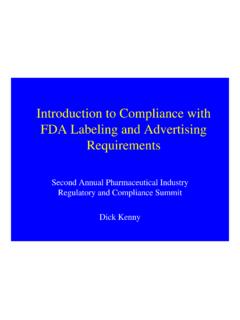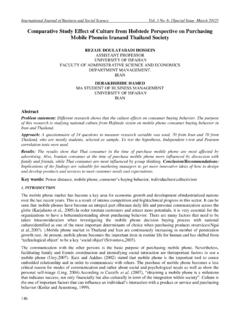Transcription of ADVERTISING STANDARDS AND GUIDELINES
1 ABC TELEVISION NETWORK. ADVERTISING . STANDARDS AND GUIDELINES . ABC, Inc. DEPARTMENT OF BROADCAST STANDARDS AND PRACTICES. 2016. Page 1. TABLE OF CONTENTS. 3-5 Introduction Overview Role of Department of Broadcast STANDARDS and Practices General STANDARDS Procedures 5-7 Alcoholic Beverages 7 American Flag (See also Public Symbols ). 7-8 Animals 8 Billboards 8-9 Chairman's Messages in Sporting Events 9-10 Challenges Competitive Challenges to ADVERTISING on the Network 11-15 Claim Substantiation (See also Comparative ADVERTISING , Product Demonstrations ). 16 Community Sensibilities 16-18 Comparative ADVERTISING (See also Claim Substantiation, Product Demonstrations ). 18 Competing Media 18-21 Contests (See also Gambling ). 21 Controversial Issues 22 Criminal Activities Demonstrations (See Product Demonstrations ). Dietary Supplements (See Vitamin Supplements ).
2 22 Direct Response ADVERTISING Disclaimers (See Supers ). 22-23 Dramatizations, Reenactments, and Simulations 23-26 Endorsements 26 Environmental Claims 26-27 Financial ADVERTISING 27 Firearms, Ammunition, and Fireworks 28 Food (See also Vitamin Supplements ). 29 Foreign Language 29 Free , Use of 29-30 Gambling (See also Contests ). 30 Government Action (See also Challenges ). 30-31 Guarantees or Warranties 31 Interstitials 32 Live, Use of Lotteries (See Contests, Gambling ). 32-34 Medical Product ADVERTISING OTC Products and Medical Devices 34-35 Motion Picture, Streaming Video/DVD, Theatricals, and Event ADVERTISING (See also Scheduling Restrictions ). Music Performance Rights (See Releases ). 35 New, Use of Page 2. 35 News Techniques, Simulation of 36 Online Dating Services OTC Drugs (See Medical Product ADVERTISING ). 36 Pet Food 36 Political ADVERTISING 36-37 Premiums and Offers 37-39 Prescription Drugs 40 Price and Value Claims 40 Privacy and Publicity Rights (See also Endorsements, Releases ).
3 40-41 Product Demonstrations (See also Claim Substantiation, Comparative ADVERTISING ). 41 Professional ADVERTISING 41 Program-Length Commercials 42 Psychic Services 42-43 Public Service Announcements 43-44 Public Symbols (See also American Flag ). 44 Releases (See also Endorsements, Privacy and Publicity Rights ). 44 Religious Themes 44-45 Safety 45-48 Scheduling Restrictions (Various Product Categories). 48 Solicitation of Funds (See also Public Service Announcements ). 48-49 Sponsorship Identification 49-50 Sports Institutionals 50 Subliminal Perception 50-51 Supers 51-52 Talent in Commercials (See also Endorsements ). 52 Technical Effects 52 Telephone Numbers 53 Texting Requests 53 Tobacco 53-54 Video Games Visual Effects (See Technical Effects ). 54-55 Vitamin Supplements 55-57 Weight Reduction and Control 57 White Coat Rule Page 3. INTRODUCTION. OVERVIEW.
4 All material broadcast over the ABC Television Network must conform to governmental laws and regulations and to the STANDARDS and policies of ABC, Inc. It is the policy of ABC to present ADVERTISING that is truthful, tasteful, and not misleading or deceptive. This policy is not only mandated by our obligation to operate in the public interest and by state and federal laws, but as a matter of good corporate citizenship. These ADVERTISING STANDARDS and GUIDELINES are for use by advertisers, their agencies and legal counsel, and for personnel at the ABC Television Network. In many cases, the policies involve specialized areas where scientific knowledge or legal considerations must be taken into account. ADVERTISING should be honest and in good taste. Claims should be substantiated and qualifying information about the attributes or use of a product should be disclosed whenever qualifying information is required to avoid misleading consumers.
5 ROLE OF THE DEPARTMENT OF BROADCAST STANDARDS AND PRACTICES. The Department of Broadcast STANDARDS and Practices ( BS&P ) is responsible for reviewing all ADVERTISING material on the ABC Television Network. Broadcast STANDARDS and Practices personnel screen and clear all entertainment programming, all commercial content, public service announcements, interstitials and on-air promotional spots, with the exception of programs and promotions produced by ABC News. Broadcast STANDARDS and Practices is an independent department of ABC reporting directly to the office of the General Counsel, Media Networks, and operating objectively, free of any allegiance to Sales or Programming departments. As a result, there is a system of checks and balances in determining the acceptability of program and ADVERTISING material. The Department also serves as a resource for ABC-owned television stations, whose managers are responsible for their own decisions.
6 These GUIDELINES represent the guiding principles of the ABC Television Network and are not intended in any way to substitute for or diminish the direct involvement or judgment of Broadcast STANDARDS and Practices. GENERAL STANDARDS . ABC reserves the right to accept or reject at any time ADVERTISING for any product or service submitted for broadcast; require deletion or revision of any material in ADVERTISING copy which violates the ABC Television Network's STANDARDS , policies, or GUIDELINES ; federal, state, or local laws or regulations; or is otherwise contrary to the public interest; and reject any ADVERTISING where the advertised product, program, or service could negatively affect its audience. Page 4. In order to determine the acceptability of ADVERTISING material submitted for broadcast, Broadcast STANDARDS and Practices has the right to investigate the advertiser and the accuracy of all statements and claims made in ADVERTISING copy.
7 When affirmative claims are made for a product or service, the law requires the advertiser to have substantiation or documentation providing a reasonable basis for the claims. An advertiser must have substantiation for all reasonable interpretations of express and implied claims in its ADVERTISING . All ADVERTISING messages should be prepared with proper consideration to the type of product being advertised, the time of broadcast, and the audience to whom the ADVERTISING is directed. ABC reserves the right to require revision of any ADVERTISING matter to meet emergency circumstances or situations of unusual significance. PROCEDURES: COMMERCIAL SUBMISSIONS. Advertisers should submit to BS&P storyboards/scripts, and subsequently rough cuts and finals, for each commercial intended for air on the ABC Television Network sufficiently in advance of broadcast to permit careful review.
8 Final commercials should be accurately labeled and slated. Alternate formats of final commercials, , High Definition ( HD ) must also be submitted for review and approval, assigned a unique ISCI code or Ad-ID, clearly identified, and properly labeled. All HD versions of commercials must be center-cut protected. Broadcast STANDARDS and Practices does not routinely review ADVERTISING which is not intended for national broadcast on the ABC Television Network. To qualify for national broadcast, products and services must generally be available in at least 50% of the country. Substantiation must be submitted for all claims. Agencies should submit information substantiating their claims with the initial submission of proposed ADVERTISING . A Broadcast STANDARDS and Practices Review Specialist reviews all commercial submissions. After reviewing a proposed commercial, BS&P may accept or reject the ADVERTISING , request revisions, or request additional substantiation for claims.
9 BS&P's decisions may be appealed to Department management. The Department of Broadcast STANDARDS and Practices treats all information and materials submitted by an advertiser or its duly authorized representative related to commercial clearance as strictly confidential. Any commercial aired on the ABC Television Network may be challenged. (See Challenges . for a discussion of ABC challenge procedures.). Page 5. ALCOHOLIC BEVERAGES. STANDARD. Beer, wine, and malt beverage ADVERTISING is acceptable, subject to federal, state, and local laws and the applicable GUIDELINES set forth here. Hard liquor ADVERTISING will be considered on a case- by-case basis, subject to federal, state, and local laws and the applicable GUIDELINES set forth here. Any commercial for or featuring alcoholic beverages may be subject to scheduling restrictions based upon the nature of the advertised product, audience composition, and other factors.
10 GUIDELINES . I. General A. All alcoholic beverage ADVERTISING must include a drink responsibly or similar message in audio and/or video. B. The following elements are generally unacceptable: 1. Direct or indirect references to, or depictions of, the strength of the product, (including statements of alcoholic content) unless used solely to establish that the product contains alcohol. General references to a reduction in alcoholic content in a given product type is acceptable, provided that there is no implication or conclusion about the safety or amount that may be consumed by reason of such reduction. 2. Representations or sound effects of drinking. 3. Depictions of unsafe or illegal activities, such as presentations that give the impression of, or promote, excessive consumption of these products;. portraying or encouraging use of these products by young people who have not reached, or appear not to have reached, the legal drinking age.





